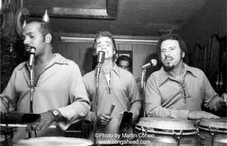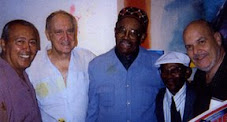
Most Anglos' knowledge of
la musica Latina begins with
Desi Arnaz and ends with
Tito Puente, with little in between. Yes, perhaps Perez Prado, called the Father of Mambo, but how about Papote, Papaito, Perico, Paquito, Patato or Pupi? Anglos know B. B. King and “Jelly Roll Blues,” but how many of them know
Miguelito Valdez, or that Cab Calloway imitated Miguelito’s authentic
Nañigo ritualistic chanting, turning it into a gibberish called “Heidi, Heidi Ho” that made a mockery of an authentic Afro incantation? It made Calloway a millionaire, with no thanks or acknowledgement to
Valdez.
One can learn to dance salsa easily enough, but where does one acquire the ability to discuss the merits of Manny Oquendo y Libre versus Larry Harlow, as Nashville does with their numerous Country Western stars, or talk about Marc Anthony and José José or the greatness of Celia Cruz?
To fully feel the music, one must know the players. Imagine enjoying your rock and roll and never knowing anything about Elvis. That is the sorry state of the Latin music scene as it concerns the Anglo adherents. Information gained concerning the music you are listening to or dancing to makes one a skilled player in the conversation setting as well as on the dance floor. Max Salazar’s Mambo Kingdom is an excellent source book along with The Latin Tinge, but more of the same is needed, especially in the popular press, on the Internet or in the living room.
The following encounters with the music and the individuals involved as experienced by an outsider, an Anglo like yourself, can bring this remarkable music into your life and give you el alma creola.
Anglos might know the “Watermelon Man,” Ramon “Mongo” Santamaria, but how many have heard of Candido (Julian Cabrera), who at age 87 is still beating conga around the world?
I first heard Candido at the Kursal club in Old Havana. It was sixty years ago while I attended the University of Havana and steered tourists around the many hot spots for pocket money. We took them to the Teatro Shanghai to see the stage show that openly featured the big star (porno), Superman, a household name.
We had mojitos at
La Zaragozana for lunch, rum añejo before dinner at
Sloppy Joe’s, Scotch and sexy super-spectaculars at
La Tropicana and a late morning dip in the pool at the Hotel Nacional. When the Tropicana show began, gamblers returned to their tables, a problem for the house, that has since been remedied in
Las Vegas by separating both activities into “rooms” that share charge admissions
Spanish names like Rodriguez make for a blended, extended “family” made more confusing by the tendency to add somewhat of a clarification in the form of “pet names.” For example, Candido Cabrera is not to be confused with Candido, the timbale player named José Rodriguez, or bongoceros using “bongo” as a middle appellation such as Bobby Romero and Harry (Bongo) Rodriguez. The greatest in my opinion and in that of many others was the extraordinary bongocero José Mangual Sr., who adopted Buyú as his stage name.
I first met Buyú in 1937 at the Café Latino on Grove Street in the Village, and was at his bedside toward the end at Mother Cabrini Hospital seventy years later. Until that meeting, the only “Spanish Music” I knew was “La Cucaracha” and “Alla en el Rancho Grande.” When Buyú beat on what some people called bongos (“tom toms”) and maracas (“rattlers”), I went searching for the real thing. I traveled from Fort Hamilton across Manhattan and up into the Bronx to the Cabarojeño Workers Circle to hear it. Closer to home was the Park Palace on 110th and Fifth Avenue. It was there that I met Julio Andino in 1937.
 Most Anglos' knowledge of la musica
Most Anglos' knowledge of la musica 

No comments:
Post a Comment